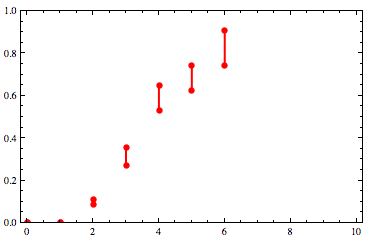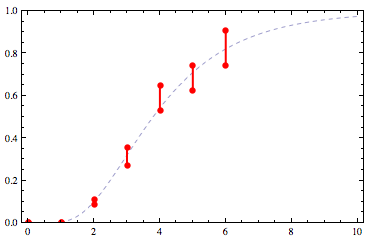Curve fitting: Find the smoothest function that satisfies a list of constraints.
Posted
by dreeves
on Stack Overflow
See other posts from Stack Overflow
or by dreeves
Published on 2010-04-23T22:52:22Z
Indexed on
2010/04/24
4:33 UTC
Read the original article
Hit count: 483
Consider the set of non-decreasing surjective (onto) functions from (-inf,inf) to [0,1]. (Typical CDFs satisfy this property.) In other words, for any real number x, 0 <= f(x) <= 1. The logistic function is perhaps the most well-known example.
We are now given some constraints in the form of a list of x-values and for each x-value, a pair of y-values that the function must lie between. We can represent that as a list of {x,ymin,ymax} triples such as
constraints = {{0, 0, 0}, {1, 0.00311936, 0.00416369}, {2, 0.0847077, 0.109064},
{3, 0.272142, 0.354692}, {4, 0.53198, 0.646113}, {5, 0.623413, 0.743102},
{6, 0.744714, 0.905966}}
Graphically that looks like this:

We now seek a curve that respects those constraints. For example:

Let's first try a simple interpolation through the midpoints of the constraints:
mids = ({#1, Mean[{#2,#3}]}&) @@@ constraints
f = Interpolation[mids, InterpolationOrder->0]
Plotted, f looks like this:

That function is not surjective. Also, we'd like it to be smoother. We can increase the interpolation order but now it violates the constraint that its range is [0,1]:

The goal, then, is to find the smoothest function that satisfies the constraints:
- Non-decreasing.
- Tends to 0 as x approaches negative infinity and tends to 1 as x approaches infinity.
- Passes through a given list of y-error-bars.
The first example I plotted above seems to be a good candidate but I did that with Mathematica's FindFit function assuming a lognormal CDF. That works well in this specific example but in general there need not be a lognormal CDF that satisfies the constraints.
© Stack Overflow or respective owner